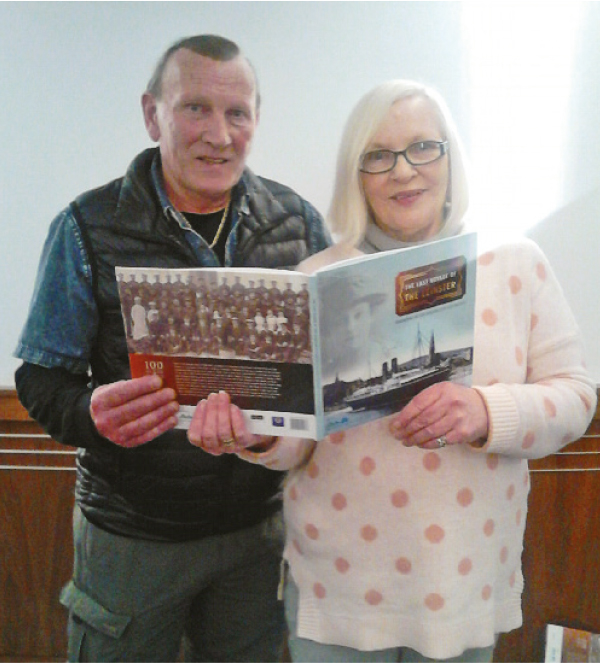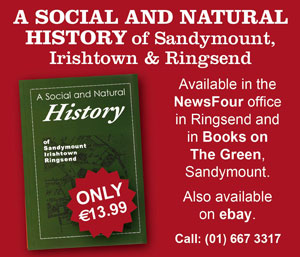
Andrew Sinkovich and Anne Burrows. Photo by Eoin Meegan.
By Eoin Meegan
This year sees the centenary of the sinking of RMS Leinster, a combined passenger and mail sorting ship that was fatally struck by a torpedo on October 10th 1918.
Eclipsed, perhaps, by other events at the time both here and in Europe, it is only fitting this great tragedy is restored to its rightful place in Irish maritime history, not only for the tragic loss of so many souls, but because it remains the single greatest loss of life in the Irish Sea or by an Irish-owned vessel.
The RMS Leinster was one of the fastest ships at sea, with a speed of 24 knots. She weighed 2,640 tons and operated between Holyhead and Dun Laoghaire – then known as Kingstown – and was owned by the City of Dublin Steam Packet Company, which had secured the prestigious contract for the Royal Mail.
The steamer left Dun Laoghaire just before 9 am that morning. The weather was fine but the sea rough. On board were 22 postal sorters, 180 civilian passengers, and over 500 military; comprising Canadian, American, Australian, New Zealand, as well as British troops.
As she passed the Kish lighthouse she met the RMS Ulster coming back from Holyhead (the company operated four ships in total on this route, all named after the provinces of Ireland), and Radio Officer Arthur H. Jeffries, who was to perish in the disaster, tapped out customary greetings to the sister ship.
At this time, the first torpedo shot across the bow. Immediately the captain ordered the Leinster to turn back, but before it could the ship took a second hit on the port side. A fateful third torpedo to the starboard caused her to sink rapidly. There is conflicting evidence as to the exact time the torpedo struck, but it’s thought to be approximately 9.45 am.
Stories of courage and bravery
There were many stories of individual bravery that morning. Outstanding was stoker William Maher who rescued a number of people, among them a young girl named Dorothy Toppin. Later she gave him an inscribed silver pocket watch expressing her gratitude for saving her life, which is in the National Maritime Museum today. Inscribed on it are the words “To William Maher from Dorothy Toppin as a small token of gratitude for saving her life ‘Leinster’ disaster 10th October 1918”.
Others scrambled into lifeboats or clung desperately to rafts in the water. These were picked up some time later by the HMS Mallard, and the Helga, famous for its shelling of Liberty Hall in 1916, and later to enjoy a new lease of life as the Free State-owned Muirchú. In total, some 560 people perished that morning, including 115 of the 180 civilians.
Among them was the Captain, William Birch, whose body was never recovered. A similar fate befell Gerald Palmer, a 14-year-old boy with a physical disability who was living in what was then known as the “Cripples’ Home”, in Bray, now Sunbeam House. Later Sunbeam House gave him his own memorial stone in Deansgrange cemetery. Another fatality was Josephine Carr, who became the first member of the Women’s Royal Naval Service, or the WRENS as they were called, to be killed in active service. She was only 19.
Another intriguing story was that of Tom Connolly, a cabin boy who later became a successful entrepreneur with a business in Dun Laoghaire. One day when Tom went into a pub in Dublin he saw a scaled model of the Leinster on display, however, despite large financial inducements he was unable to persuade the owner to part with it. But as chance would have it a friend of Tom’s bought the pub, along with all the contents, some years later and made him a present of the ship. Today it is also on display in the National Maritime Museum in Dun Laoghaire, and worth the small entrance fee alone just to see it.
Of the 22 postal workers, only one survived, John Higgins, from Glasnevin. The postal sorters worked in the mid-section of the ship, which took the biggest hit, and when Higgins went to escape he found the steps leading to the upper deck had been blown off. Luckily, he had the presence of mind to grab two dead electric cables (the power had been knocked out in the explosion) and managed to hang on until the waters rose, lifting him clear until he could go through the hatch door. The chief stewardess Mary Coffey also survived, as did Louis and Cora Daly from Cork, on board that morning setting out on their honeymoon. Let’s hope they got to enjoy it eventually.
Joseph Robinson
On October 10th Joseph Robinson went to work like any other day. Joseph worked as a postal sorter and had been with the post office for 21 years. He lived with his family in Drumcondra and was known as a gentleman, kind to everyone. He was married and had six children, among them Annie, who was only five years old that fateful day.
Despite her tender age Annie remembered her father and remembered waving goodbye to him as he left for work that morning. Although she couldn’t have known it then, it was to be the last time she would ever see him, as Joseph Robinson was to perish in the disaster. He was only 43.
Joseph Robinson was the maternal grandfather of Andrew Sinkovich and Anne Burrows. I felt privileged to have met them when they travelled to Ireland from New Zealand last October and was moved by their closeness to their lost relative. After a showing of the short film “RMS Leinster Commemoration” narrated by Love/Hate actor Paul Coonan in the Savoy cinema, we repaired to the Gresham hotel next door for a cup of coffee. “We are so glad we came over for the centenary commemorations,” Anne told me, “it’s been a very moving time for us both.”
Joseph has always been a living presence in their lives, kept alive by their mother Annie, the little girl who waved goodbye to him that fateful morning.
They both speak of him with such tenderness that it was almost as if they had known him while growing up. And although their grandfather’s body was never recovered his name is proudly on the family headstone in New Zealand.
In November 1922 Joseph’s widow, her six children, the eldest being only fifteen, and her father made the decision to emigrate to New Zealand. Young Annie was nine years old at the time. New Zealand became their permanent home and it is here that both Anne and Andrew were born. As well as these six children, Joseph has left five grandchildren, five great-grandchildren, and so far one great-great-grandchild, Tom O’Reilly, who is now 12 years old. Annie lived until 2012 and died only a few months short of her 100 birthday. She enjoyed a long and fruitful life.
Anne came up with the idea to put a little booklet of photographs and dialogue together to be distributed to friends and family, including many newly discovered family members in Ireland to mark the event. It contains photos of their grandfather, naturally, as well as photos of young Annie at school in Dublin, and Anne and Andrew’s family growing up. “We’ve been planning this trip for a long time now,” Andrew said, “we’re both very touched by all the events that are organised around it, and the effort people put into it.”
Retired now, Andrew worked all his life for Telecom, the New Zealand Post Office. It still runs in the blood.
The sinking of the Leinster was a tragic and senseless loss that affected the lives of so many. And what was particularly poignant was that it happened only a month before the armistice and the breaking out of peace.



